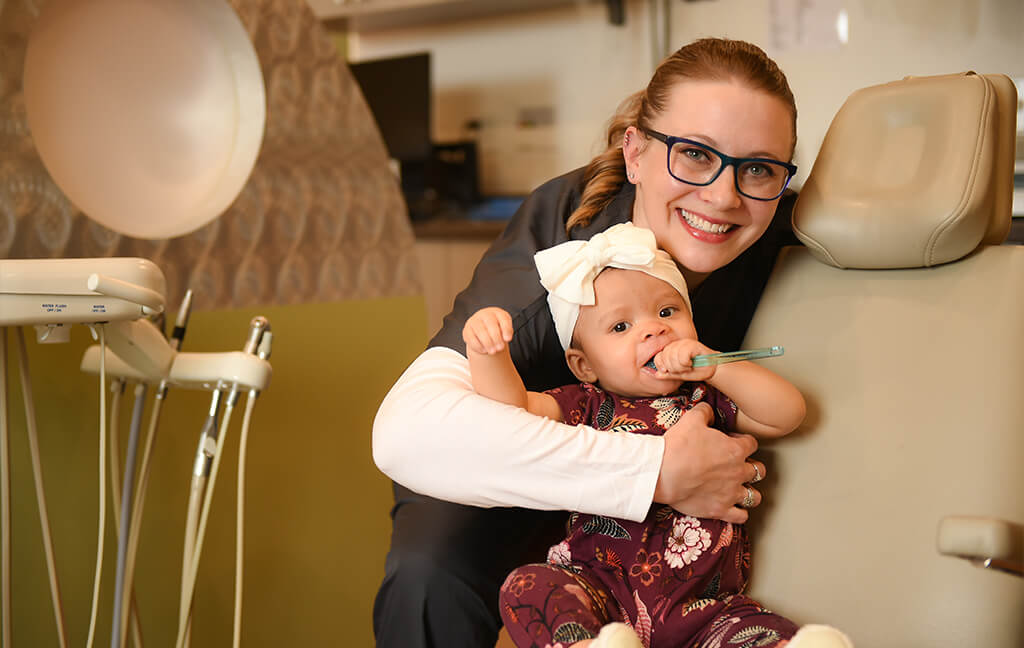They’re called the “terrible twos” (and “terrible threes”) for a reason. We all know that toddlers can be, shall we say, stubborn. Any parent who has ever tried to brush an uncooperative toddler’s teeth would probably agree!
Brushing your toddler’s teeth may sometimes feel like a battle – but it’s one you need to continue to fight to get your child on the right track for a healthy smile. Smiles in Motion Pediatric Dentistry is here to explain the best ways to brush your toddler’s teeth and why starting good brushing habits now can make a world of difference.
Why brushing your toddler’s teeth is so important
It all comes down to one reason: preventing cavities. Young children, including toddlers, get cavities more often than most people realize.
According to the American Academy of Pediatrics (AAP), 28 percent of children have at least one cavity by age three. And sadly, things don’t get better with age – nearly half of all children have at least one cavity by age five.
Toddlers are especially susceptible to cavities because of their habits, from sucking their thumbs to sipping on half-filled baby bottles or sippy cups as they fall asleep. Baby bottle tooth decay is a real threat to your toddler’s oral health – in addition to cavities, it can cause pain, infection, premature tooth loss, poor eating habits, speech issues, and more.
The fluoride in toothpaste plays a big role in preventing cavities and tooth decay from forming in your little one’s mouth. The AAP recommends using a tiny dab of fluoridated toothpaste (about the size of a grain of rice) every day as soon as your baby’s teeth begin to come in.
A timeline of dental health milestones
Here’s a brief timeline to help give your child great dental care at every age, including age-appropriate dental visits and cleaning habits:
From birth – Start by wiping your baby’s gums with a soft, damp washcloth twice a day. As soon as their first tooth erupts, use a soft infant toothbrush or washcloth to brush their teeth with that rice-sized dab of toothpaste.
First dental visit – The American Dental Association and Smiles in Motion Pediatric Dentistry both recommend bringing your child for their first dental visit at age one.
Full set of baby teeth – From age one to three, your child’s mouth will be busy! Most children have all 20 baby teeth by their third birthday. During this time, be sure to visit Smiles in Motion Pediatric Dentistry twice a year for routine cleanings and exams. You can upgrade to a pea-sized dab of fluoride toothpaste once your child reaches age three.
Some children are ready to brush their teeth on their own by age six, while others need supervision for a year or two longer (especially if there are any signs of tooth decay). Your Smiles in Motion pediatric dentist can help identify if your child is ready to take over brushing themselves.
Make brushing more fun
While we’d all love for toddlers to sit still, open their mouths wide, and say “Ahh!” at brushing time, that’s not often the case. These tips can help make brushing more fun if your toddler refuses or is going through the teething stage:
- Let your child “brush” their favorite stuffed animal or doll’s teeth (without toothpaste, of course) while you brush theirs.
- Play or sing a song that lasts about two minutes – when the song’s over, so is brushing!
- Use a sticker chart or other incentives to celebrate each time your toddler cooperates while brushing their teeth.
For more advice on how to get your toddler to brush their teeth, ask your Smiles in Motion pediatric dentist.
Brushing techniques for toddlers
Ready to get started? Here’s a step-by-step description of how to brush your toddler’s teeth:
Step 1 – Have the right supplies
You’ll need a soft child-size toothbrush and fluoride toothpaste. Letting your child pick a toothbrush with their favorite color or favorite cartoon character can add some extra excitement. They may also want to try a fun toothpaste flavor, like bubble gum. Any flavor is fine as long as the toothpaste is fluoridated.
Step 2 – Prepare your toddler for what’s going to happen
There are lots of creative ways to prepare your toddler for brushing their teeth, such as watching a kid-friendly video about healthy dental habits or showing them how to brush on their favorite stuffed animal or doll.
Step 3 – Get the toothbrush ready
If your toddler is under the age of three, you’ll need a tiny dab about the size of a grain of rice. Once they turn three, you can use a pea-sized dab every time you brush. Be sure to tell your child not to swallow the toothpaste, which can upset their stomach.
Step 4 – Time to brush
Your toddler may want to brush their own teeth first, especially if they’re extra stubborn or independent. Make sure you supervise them while they brush and then take over when they’re done. Gently brush the surface of all their teeth, including the “hidden” ones in back.
Step 5 – Spit out any leftover toothpaste
Swallowing a tiny dab of fluoride toothpaste is fairly harmless. But once your toddler begins using more, swallowing toothpaste could give them an upset stomach. Show your child how to spit out excess toothpaste – just don’t forget to remind them to aim for the sink.
That’s it! You’re all done until the next brushing.
Schedule an appointment for your toddler today
The caring team at Smiles in Motion Pediatric Dentistry is ready to give your child a healthy smile that lasts a lifetime. The toddler years are crucial, starting with their first dental appointment at age one. With proper brushing techniques and quality care from our pediatric dental experts, we’ll help your toddler get the best possible start.
To schedule your appointment, contact Smiles in Motion Pediatric Dentistry today.
